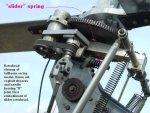Joe Pires;n1132323 said:
John, the MTO had a cap on the butt end of the blade. He took it off and slid the washers in. Fara, according to Mike, the purpose of removing vibration is to increase comfort and reduce stickshake. If reducing a vibration has no resulting benefit it is wasted effort, or at least that is how I understood his comment. You should ask him.
I think there is definitely a lack of understanding or misunderstanding there. That is not the purpose of balancing. In fact after balancing the blades for 1 per rev you may still have vibration in the cabin that is 2 per rev or others coming from the engine or prop or tail or rudder etc. He clearly instructs this in his intro course so everyone understands why we balance rotors and what should we expect and what we should -not- expect. I and a few others just took the intro as well as the whole course from him and I ate his brain out in the other days he has been here. Very very informative and actual data driven class. There is a science and method to it and its important to get the X (lateral) and Y (longitudinal) IPS down at the rotor below 0.2 IPS. If you'd like I and Greg can fly there one day and make the move lines for your gyroplane and show you what its doing or if move lines can even be made.
Balancing and smoothing using balancers is usually acting on 1 per rev which is either vertical or lateral imbalance of lift being created by each blade at a given point.
1 per rev can sometimes greatly mask 2 per rev vibration but when 1 per rev smoothing is done and accomplished, sometimes 2 per rev remaining vibration is now perceived by us as more annoying when the same was masked before and we never knew it was bad. These balancers do not work on n per rev solution, mostly 1 per rev solution only.
2 per rev and its causes are debated all the time. There are different theories of 2 per rev thrown around here on this forum as well. Rotor blade flapping to equality is likely a big contributor but there are other factors as well I am sure.
As an article from NASA (?) states:
" It is true that the smoother a rotor system is, then it tends to unmask the Nper rev vibration such that they appear a lot worse to the aircrew inside even though no adjustments were done to the absorbers. This is because the higher levels of 1 per rev vibration tends to mask the N per rev vibration. As the 1 per rev levels are reduced toward zero, the N per rev vibe becomes APPARENTLY more noticeable. If you were to take actual IPS level readings, you would see that the actual IPS magnitude has not altered – merely become more noticeable."
This shows you that just having your cockpit "feel" good isn't doing anything to some of the vibrations that may be highly damaging to components and shortening their lives.Sometimes perfect balance in 1 per rev has to be sacrificed a little to mask the 2 per rev so your cockpit feels acceptable while also improving 1 per rev smoothing to an acceptable level and not leaving it at a dangerous level. Things like spring suspension mounts on transmissions in 206, 205 etc. are serving similar purpose as the so called "slider" in your rotor head on a similar principal I think except not on the R&P block but further down
Hope to see you at Bensen Days.

